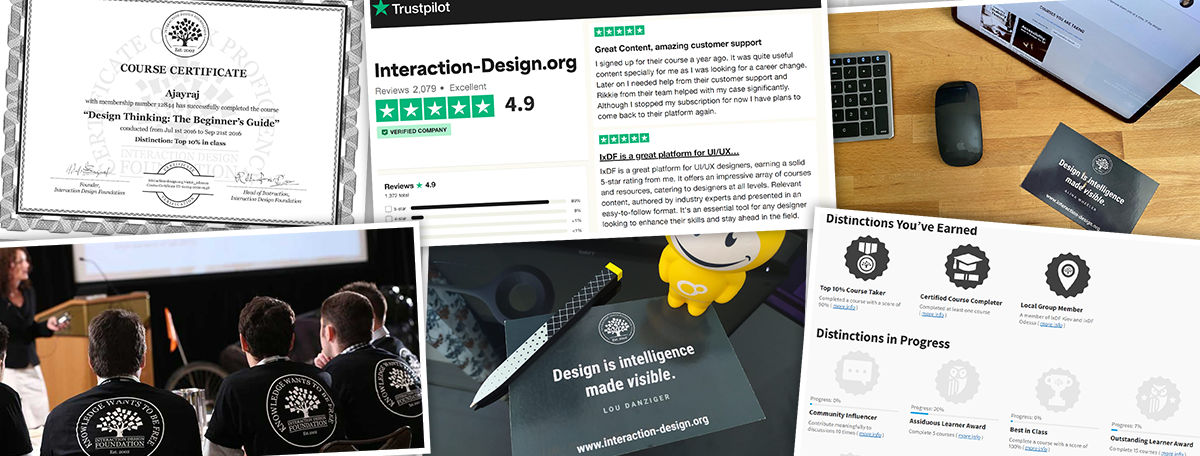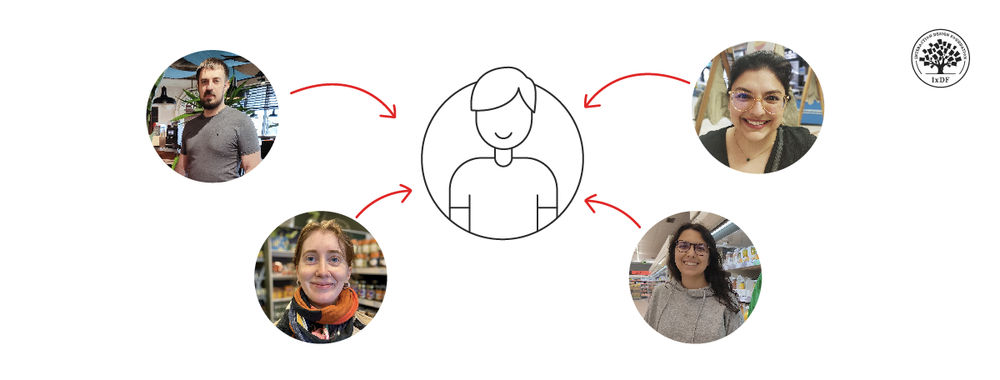For as long as we’ve been running the Interaction Design Foundation, we’ve been asked many of the same questions: for example, “I know nothing about UX Design; can I still benefit from your courses?”, or, “Can I use my graphic design experience to become a UX Designer?”.
Rather than answering these common questions ourselves, we figured we should let our members do the talking! By compiling snippets from some of the in-depth, empathetic reviews our members have been kind enough to write over the years, we’re sure you’ll find that most of your questions will have been answered by the end of this piece. Let’s get to it!
Table of contents
- IxDF Courses
- Are your UX courses suitable for beginners, or those looking to change careers?
- Why should I choose the IxDF when there are so many different competitors offering similar courses?
- Are your courses just for individuals, or can they also be used by freelancers or by companies to train their teams?
- Are your courses useful for professionals and design teams already working in the industry?
- IxDF Certificates
- Master Classes
- Studying at The IxDF and Online Education
- If I’m studying UX at university, will I still benefit from becoming a member?
- Why is an education in UX, Design Thinking and Interaction Design so relevant at the moment?
- Will I feel an active sense of community if I join the IxDF?
- Is an online education really comparable to programs offered at prestigious universities?
- Is it true that there are real-life course instructors involved to help you learn and grade your work?
- Can non-members benefit from the Interaction Design Foundation?
IxDF Courses
Are your UX courses suitable for beginners, or those looking to change careers?
Carlos Del Moral’s review is a great place to start for this.
“The Interaction Design Foundation is a great place to start if you want to discover the UX Design world. I’m sure that in each course you’ll find a lot of interesting information that you can immediately put into practice in your work. If you don’t know where to start don’t worry, you can choose a learning path from a variety of options, in my case I chose “Marketer” with 7 different courses that will give me a better understanding of fundamental UX concepts.”

If you’re curious about Carlos’ story, read his full review here.
Now, if you’re looking to change career into the world of UX, then you might resonate well with what Ajayraj has to say:
“I started my career as a developer, but my passion has always been in design, psychology and solving problems…. So, I planned to switch my career to become a UI/UX designer.
The initial phase was rough and blank as I had no clue where to start, whom to ask and how to proceed. I surfed the internet about UX related stuff, and it is like travelling inside a dense jungle with no start and end, no sense of orientation, and I was literally lost.
Then I came to know about IxDF and it was a happy story after that. They have content for beginners who have no clue about UX design, and they guide you throughout the whole course with proper examples, theories and concepts.
IxDF played a key role in helping me to get the UI/UX designer job that I was dreaming of. The courses give you so much insight, and the certifications are recognised and valued by industries and organisations worldwide.”
 You can read more about what journey Ajayraj has been on here.
You can read more about what journey Ajayraj has been on here.
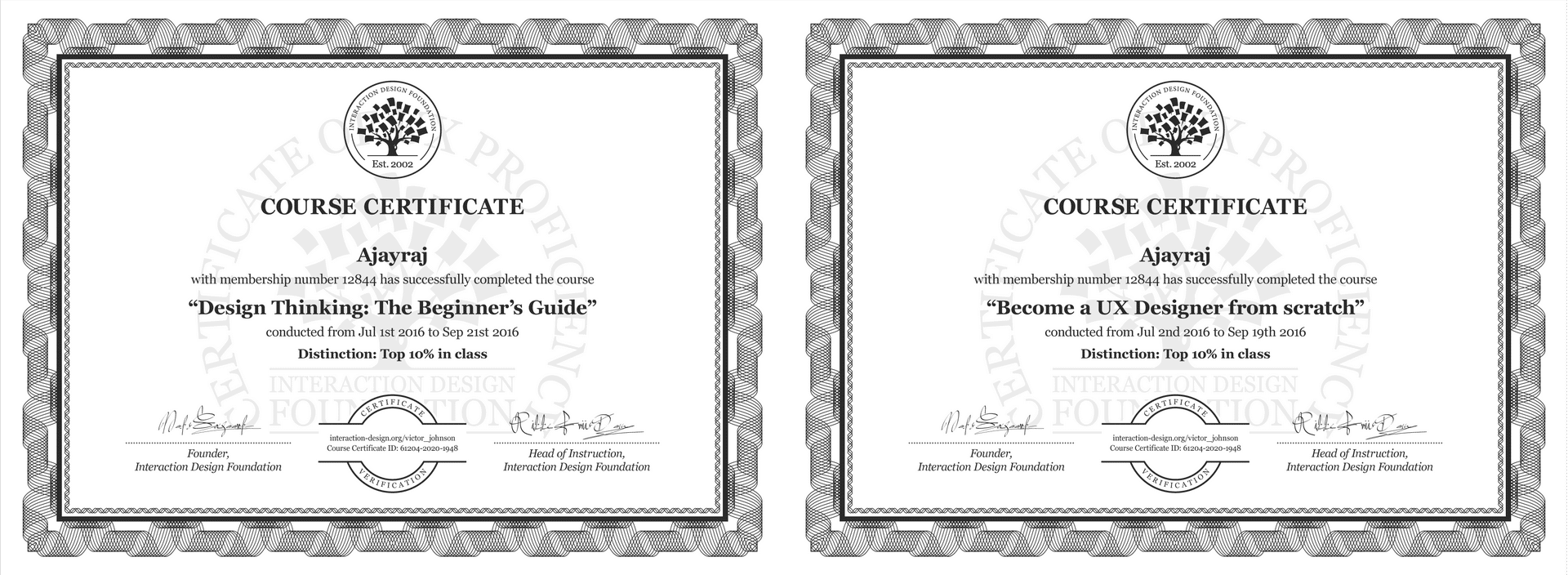
As you can see, the Interaction Design Foundation has courses for everybody—no matter what situation, or stage of your career, you’re in. Don’t know a thing about UX design? No problem; we’re here to get you started. Already built two beautiful digital products that are super successful? Great! Head to our advanced courses and—for all you know—you might just get a brilliant idea for what your next project should be.
If you don’t know where to start, choose a learning path at the UX courses section. We have prepared several options for you to help you achieve your learning goals.
Why should I choose the IxDF when there are so many different competitors offering similar courses?
In Rhys Merritt’s words:
“After looking into some courses like udemy, nngroup, and general assembly, we were a little put off by price and availability — then we found Interaction Design Foundation, and it seemed to answer all of our questions, and then some. Not only was it remote friendly, but we only paid a fraction of the price, compared to what others were charging… and that was for a full year of access to any course! It was our answer.”

You can continue reading Rhys’s full story here.
Asif also had something to say in this regard:
“I did a thorough research and cross-compared based on my work to conclude that IxDF fits in with my requirements.
I just had a few thumbs up guiding my decision:
Their yearly membership fees for professionals are extremely modest and it gives you access to as many courses as you wish. To me, that’s quite cost-effective.
People behind IxDF are some of the most prominent names from UX/UI industry like Donald A. Norman, Daniel Rosenberg, Irene Au, Jonas Löwgren, Ken Friedman, Michael Arent and Bill Buxton.
IxDF provides a designer’s community platform where designers from all over the world can interact with each other and also you can meet designers from IxDF community within your area.”
 You can read Asif’s full account of Learning every day as a Designer here.
You can read Asif’s full account of Learning every day as a Designer here.
If you’re specifically wondering about the differences between the Google UX course and IxDF courses, read Tom Richards review:
The Google UX course seems more accessible and it is very slick and well put together, a great place to start. But once it ends, it ends. Not only that, you are learning Google's way.
The IxDF membership is a bit more freeform and your learning may be a bit more spread out, but it is also a fantastic place to start. Where its strengths lie is that it isn't just a great place to start. It's a great place to stay, as there is always more to learn and there is a worldwide community.
We’ve tackled the question of how much money people should invest in their design education at some length in “How to calculate the ROI of a design education”. Simply put, at as little as $14 a month, there’s no comparison between our offering and that of our competitors. Our first and foremost motive as an educational institute is to make design education accessible to everyone.
We publish hundreds of textbooks and articles that are completely free to read, and as we cover more and more of our costs, we cut down membership fees. In addition, we offer different types of education formulas so you can choose the one that best suits your needs.
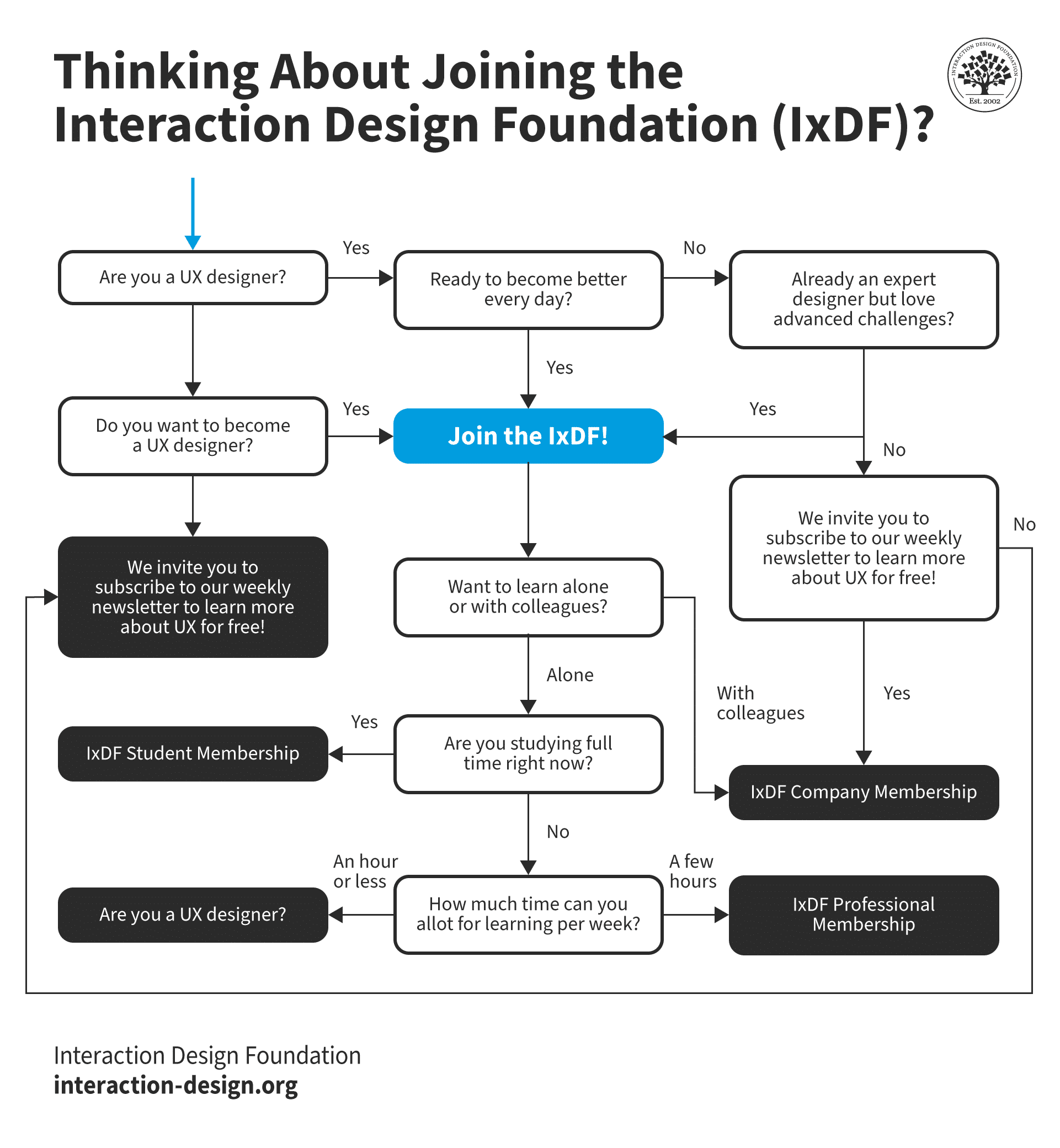
If you’re thinking about joining the IxDF but you don’t know where to start, follow this flowchart to find out which learning style might suit you best.
Are your courses just for individuals, or can they also be used by freelancers or by companies to train their teams?
Along with helping individuals to achieve their career goals, we also provide training for businesses who are looking to upskill their teams in the field of UX. From tech giants such as IBM, SAP, and Accenture to organizations including the United Nations and the State of New York, we provide memberships that teams can learn and benefit from on a global scale. And it’s not just large companies that are taking advantage of learning UX design—we also have young startups and other small to medium-sized enterprises joining us... all you need is a team of two!
Su Wiemer tells us how she doubled her freelance income as a UX designer and learned from IxDF courses:
“I love my work now more than ever, and I have doubled my earnings. So it’s easy for me to say: all the effort has paid off.
If you want to get started as a freelancer like I did, I’ve one last recommendation: take the course “How to become a Freelancer” at IxDF. This course teaches you what you need and how to get started, and gives you a good dose of courage to take the first steps.”
 Read Su’s full story here.
Read Su’s full story here.
Jonathan from the UX & Product Design Team at CEMEX tells us his story:
“Learning through the IxDF portal has been a great experience for us as a UX & Product Design Team at CEMEX. It has not only helped us to increase our knowledge in UX related topics, but it has also given us various tools to improve the design and adoption of the digital assets we have [...]
We strongly recommend the Interaction Design Foundation portal. The whole UX & Product Design team has an IxDF account and learning through the portal has been part of our career growth.”
 Read Jonathan’s full review here.
Read Jonathan’s full review here.
Besides the UX team, many other teams within an organization can benefit from the IxDF’s Company Memberships, from sales and marketing teams to product managers, to developers and engineers—we have drawn customized training paths for every job role.
Are your courses useful for professionals and design teams already working in the industry?
Absolutely! In fact, we ran a check through our member database, and over 65% of our members are professionals working in the design industry. This includes professionals who sign up by themselves to personally improve their knowledge and skill sets, as well as members who are part of company memberships. These range from small design agencies who sign up five members of their team, to large companies such as SAP, IBM, Adobe and Accenture who get thousands of their employees to take our courses. Our emphasis on combining design examples, timeless concepts, and theory makes it very useful for professionals who want to adapt and apply knowledge to different contexts.
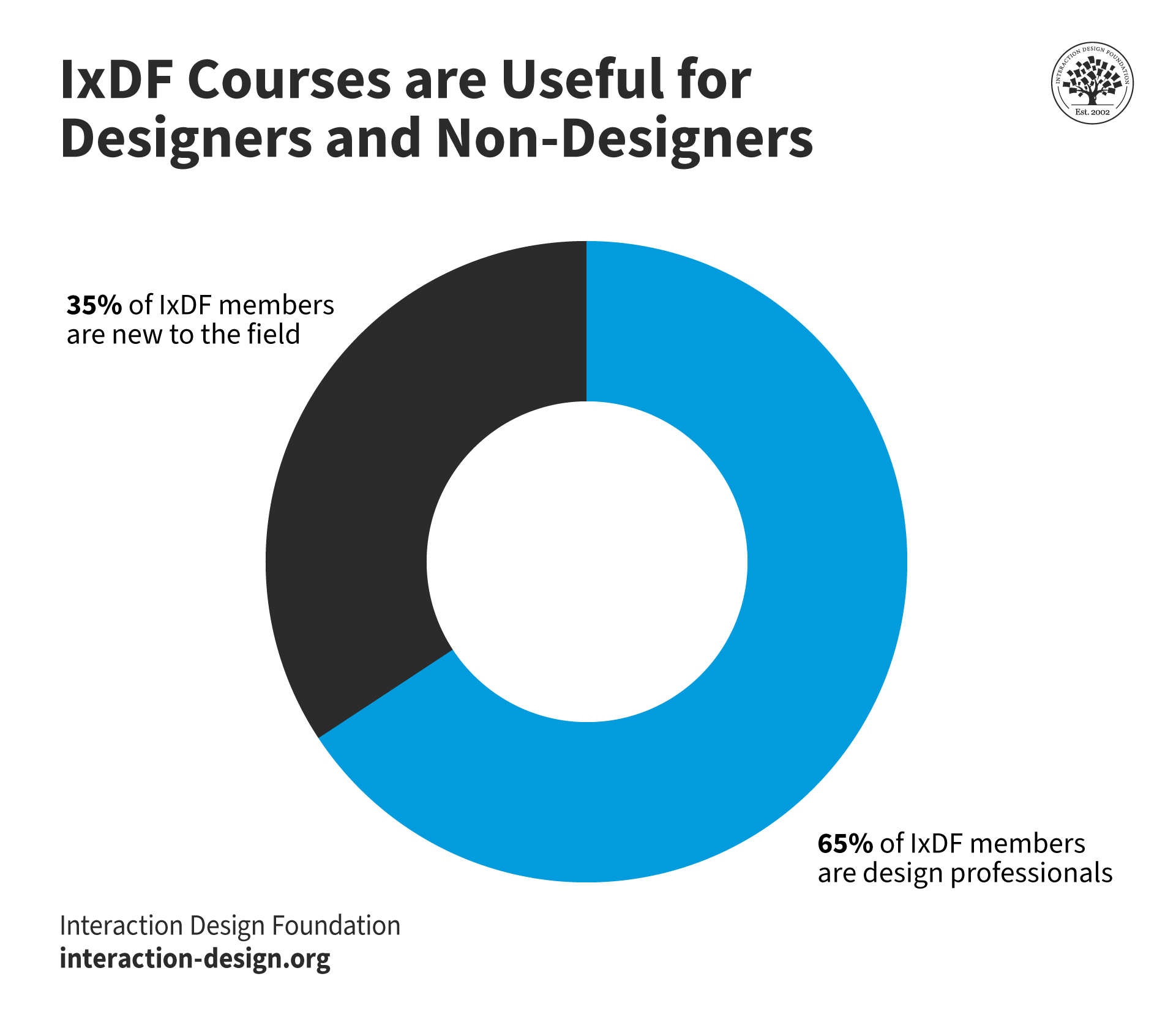
The IxDF offers education to both design professionals and newcomers to design.
Just have a look at Fernando M. Carreon’s story:
“I work as an Interaction Designer at one of the big companies at Silicon Valley and I have been here for a little bit less than a year. 15 years ago most of us at the Web business were Jacks of all trades, but you may know that to have a strong value as a professional you must specialize on whatever you must love. I always try to be informed about anything and Interaction Design is not an exception, so when I discovered The Interaction Design Foundation, I decided that I must give it a shot. I got access to tons of information and UX courses. It was better than having an exclusive Interaction Design or UX library. The way of learning kept me focused and engaged as I could interact with other Interaction Designers while taking those valuable courses.”
 You can read Fernando’s full story here. It’s appropriately titled “Improving your career with Interaction Design Foundation”.
You can read Fernando’s full story here. It’s appropriately titled “Improving your career with Interaction Design Foundation”.
The UX manager Geoffrey Doran has this to say:
“I have completed 2 UX courses so far (User Research — Methods and Best Practices and UX Management: Strategy and Tactics) and I have found them both to be very useful for my role in the company. I lead design teams now and have been growing our company’s design offering for over 3 years, so the UX Management has given me a lot of extra knowledge and management tips to help me to grow the team and our design capabilities.”
 You can read Geoffrey’s full review here.
You can read Geoffrey’s full review here.
IxDF Certificates
Are the course certificates awarded by the Interaction Design Foundation worth anything?
Industry recognition is extremely shady territory; everyone claims to offer it, and thus the importance of authentic signifiers of knowledge gets diluted. So, why do industry leaders verify and trust the IxDF’s course certificates? There are two major reasons.
First of all, the IxDF’s content is made with contributions from faculty at Ivy League universities such as MIT, Stanford and Harvard, as well as industry professionals from IBM and SAP.
Secondly, the people behind the IxDF are some of the most prominent names in the UX industry—Don Norman, Daniel Rosenberg, and Irene Au… just to name a few.
And last, but not least, our course certificates are trusted by global industry leaders, who have themselves taken up company memberships with the IxDF. Here are some of them:

You can rest assured knowing that gaining course certificates from the IxDF will really make a difference when you’re looking for your next job.
Besides the importance of the certificate itself within the industry, Rishav Haldar explains what the certificates meant to himself:
“With a Master's in Applied Economics and a Bachelor’s in Commerce, I wasn’t the most exciting candidate when applying for jobs. Listen, it’s not that the industry does not give you a chance. I would say that the world of UX is quite welcoming— always looking for new minds for a fresh perspective.
But the problem was that I didn’t feel all that confident in myself. Going into an interview to talk about all this stuff that I had no background in made me feel weird. With 2 IxDF certificates, all that changed. I actually felt confident going into interviews.”
 Read Rishav’s full review here.
Read Rishav’s full review here.
You earn a course certificate for each course you complete and can highlight your achievements by adding them to your résumé/CV, LinkedIn profile, or website.
Can I share my certificates even if I discontinue my membership with the IxDF?
Your certificates are a testament to your hard work, and they will always be yours, even after you discontinue your membership.
Robert Ruediger has used the IxDF to change his career, and on this matter, here's what he had to say:
“The best part about the IxDF courses is that completing them results in a certificate that can be shared with the world. I personally strive to answer every question in each course because higher grades result in more distinctions for your certificates as well.”
 Read Roberts's full review here.
Read Roberts's full review here.
Your certificate will still be valid even if you discontinue your IxDF membership. When you complete a course, you’ll get a digital certificate that’s displayed on your IxDF profile, and you can also share it on LinkedIn. In addition, you'll receive a downloadable copy that you can print and share if any employers or recruiters need you to. Also, the link to the digital certificate will remain active and thus, you’ll always have proof that you have completed an IxDF course, and your IxDF profile will also remain active.
Master Classes
How are Master Classes different from other webinars?
The IxDF Master Classes are presented by top industry leaders, and they are thoroughly curated to bring specific value to UX professionals and students. They are the perfect complement to your UX education and help you stay up-to-date, even if you’re short on time.
In his review, Dimitar Stojmenovski shares his experience after attending several Master Classes:
“The Master Class Webinars have brought me as much added value as well. I had the pleasure to attest to some great ideas from the likes of Don Norman, Steven Hoober, Zoltan Kollin, and many others. Furthermore, students have full-time access to all the lectures and recordings from the Master Class Webinars at their disposal whenever they might need them.
The opportunity to learn from the masters of the craft themselves was a great experience for me and none of this would be easily possible if not for the affordable memberships that Interaction Design Foundation are offering.”
 Read Dimitar’s full story here.
Read Dimitar’s full story here.
Studying at The IxDF and Online Education
If I’m studying UX at university, will I still benefit from becoming a member?
Not only is the answer to that question “yes”, but we even have a discounted “Student” membership especially for people in such situations. In our constantly changing world, there’s nothing more important than supplementing your classroom learning with other resources when you get home. You might be super inspired by your professor; however, without a properly organized library of material, you’ll find it very difficult to remain intellectually stimulated outside of the classroom. This is where our self-paced online courses can come in handy—by providing you with access to a wide variety of essential educational material that your university is often not able to provide.
“I am a graduate student in HCI and UX design. During this frantic and frenetic ‘season’ of my life, all I can think about is how much I can learn now, in order to feel confident at work, after I graduate. This is where IxDF has been most helpful. If you don’t have time for using the foundation’s website for networking, for reading randomly the research articles, then you can really focus on your weak points through their courses. IxDF’s courses filled a lot of the gaps in my graduate education, and they are specialized by topics that are narrow enough for you to feel like a specialist, once you complete them.
The courses range from Design Thinking, to Gestalt Psychology, Information Visualization and Mobile User Experience—anywhere up to about 30 courses running at any given time, and they range from beginner to advanced. What is special about the courses at IxDF is that they are comprehensive, well-founded in research, and very thorough. They make you think. And it is hard to go through more than a paragraph without having to take a thinking break, just to digest the material and incorporate it deep into the personal knowledge storage. Then, all this knowledge is immediately applicable in my courses, providing a competitive edge, and making it an all-around satisfying experience.”

Read Vera’s full review of the Interaction Design Foundation here; this one’s written specifically for students enrolled in HCI and UX courses at university.
Why is an education in UX, Design Thinking and Interaction Design so relevant at the moment?
The real world is rapidly changing because of the digital interfaces all around us. With more and more complex ideas being tackled, designers need to undergo intensive learning to build digital products that are truly great.
Our attempt to focus on timeless design knowledge and skills, rather than knowledge and skills which are quickly outdated, makes our courses ideally suited for both beginners who are new to the field, as well as experienced design professionals looking to expand their skill sets and further their careers.
Sergio Haruo also writes on this topic:
“I have worked mostly with print design and now I want to work with digital product design. One of the reasons I find interaction design so interesting is that it analyzes design and human behavior – subjects that I am highly interested in. Another reason is that digital products can be updated as we better understand the necessities from users and results can be measured easier than print design, giving a great feel that your work had an actual impact on the product.”
 You can read Sergio’s full review of the Interaction Design Foundation on the UX Blog.
You can read Sergio’s full review of the Interaction Design Foundation on the UX Blog.
Will I feel an active sense of community if I join the IxDF?

We’ll let Adesh Shah answer this one
We know that learning is best done together. With almost 700 IxDF Local Groups in 100 countries all over the world, being a part of the IxDF’s learning community is always easy, and you will soon notice just how extensive the benefits are. Take part in your local group’s activities to expand your local career network, meet your next employer, employee, and client, and connect with like-minded people, some of whom you will likely soon call friends. When the world becomes smaller, learning and connecting become easier.
Is an online education really comparable to programs offered at prestigious universities?
Forbes Magazine ran a wonderful feature on our mission here at the IxDF—and it’s perfect for getting this one answered. In the first sentence, the author compares our courses to the caliber of those you would find at an Ivy League university:
“Imagine getting an Ivy League level education in UX, product design or human-computer interaction from the comfort of your home – anywhere in the world. What sounds like the offer from a spam email is actually the open-source education reality”
Read J. Maureen Henderson’s full feature on the Interaction Design Foundation in Forbes Magazine.
Is it true that there are real-life course instructors involved to help you learn and grade your work?
IxDF member Paolo Sammicheli writes:
“The thing that I appreciated most is that for many lessons you got exercises to do that are not the typical multi-choice tests. You've to write the answers in plain English and then the trainer will review it providing feedbacks and suggestion. That's really valuable for the students, especially for those who are not English native speakers like me: It helps also in practicing the English language while staying at home.
Trainings are self-paced so you can find the time even in busy schedules to follow the class and read the material. This is perfect for workers, especially for those who commute every day.”

Read Paolo’s full review of our user experience courses here.
Having dedicated course instructors is one of the things that makes us stand out way above the rest. Mentors, coaches, teachers—call them what you will—there’s simply no alternative to learning from experts who’ve been there and done that. “Peer-reviewing” is popular on many MOOC platforms, but it is at best a mediocre alternative to no grading at all. Compared with that, our courses involve long-answer questions where your written answers get graded by real humans.
Can non-members benefit from the Interaction Design Foundation?
Kat Rigdon talks about the IxDF’s open-source library:
“I want to mention the well-curated knowledgebase that IxDF continues to add to on a daily basis. I find it really handy to share articles with colleagues who may need more information on specific UX topics, especially because each article is written in an easy-to-understand way whereby even people who are new to UX can gain a somewhat solid understanding of the concepts discussed. As mentioned earlier, IxDF offers some really great downloadable content as part of their courses but they also offer a lot of it for free within their library. The easy-to-use templates and the step-by-step instructions within articles have been an enormous help to me over the years both as a member of IxDF and a non-member.”

Read Kat’s full review here.
Our model of open-access publishing offers an alternative to academics and professionals wanting to share their work. Traditional journals and academic publishers work on outdated models of paywalls that benefit no one. At the cost of forgoing some royalties, authors publishing with us have the satisfaction of knowing that their work will have a massive impact on the world and will be read by hundreds of thousands of professionals and students.
The benefit to our readers is obvious—without any monetary investment, they get access to the latest cutting-edge research in user experience and design. Ultimately, the net benefit of free information is invaluable, and our readers have enough content to literally never stop learning.
